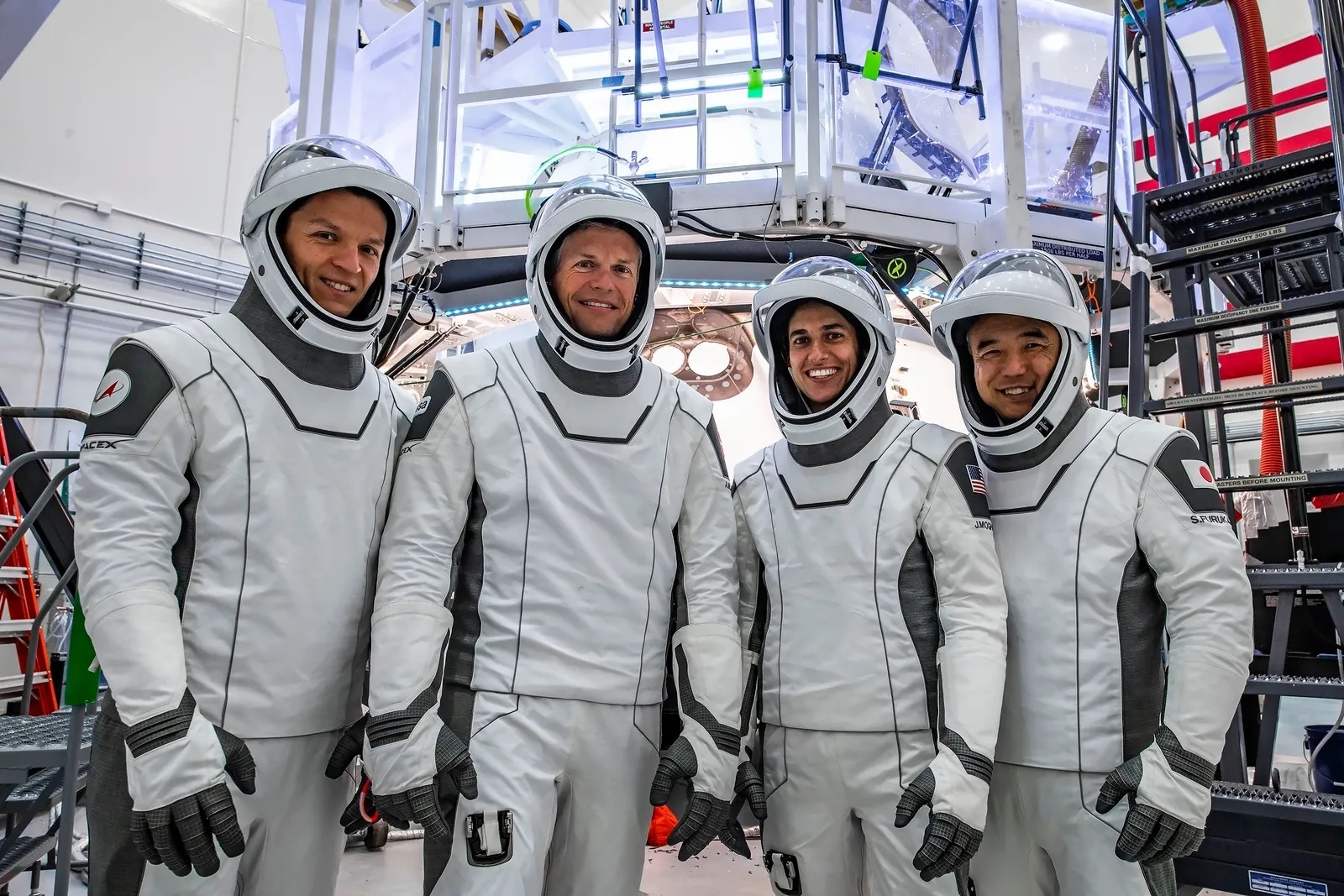1.08.2023

The crew of Crew-7 — Konstantin Borisov, Andreas Mogensen, Jasmin Moghbeli and Satoshi Furukawa (left to right) — are completing preparations for a launch to the International Space Station as soon as Aug. 17. Credit: SpaceX
WASHINGTON — Two crewed missions remain on track to launch to the International Space Station over the next month and a half after addressing technical issues that included a Soyuz coolant leak.
At a July 25 briefing, NASA officials said they are planning the launch of the Crew-7 mission to the ISS no earlier than Aug. 17. That mission, on a Crew Dragon spacecraft, was scheduled for Aug. 15 but pushed back two days to allow sufficient time to change over Launch Complex 39A from Falcon Heavy to Falcon 9.
At the time of the briefing, a Falcon Heavy was scheduled to launch July 26 carrying the Jupiter-3 communications satellite. That launch was delayed two days because of a technical issue, but successfully lifted off late July 28.
Neither NASA nor SpaceX have said if that slip will also further delay Crew-7. At the briefing, Steve Stich, NASA commercial crew program manager, said that if Crew-7 does not launch by Aug. 18, the only available launch opportunity before Aug. 25 would be Aug. 21 because of Progress cargo spacecraft operations at the station.
Benji Reed, senior director for human spaceflight programs at SpaceX, said preparations for Crew-7 were going well. He stated that, on the previous cargo Dragon mission, CRS-28 in June, there were problems with isolation valves in the spacecraft’s propulsion system that were stuck open. Those valves, used only if there is a thruster leak, were apparently corroded and remained open, although they were not needed.
“We’re proactively inspecting isolation valves across all of the Dragon vehicles,” he said. The valves on the Crew-7 spacecraft are working normally, as well as those on the Crew-6 vehicle docked to the station. “We feel confident in the Crew-6 vehicle that is on station. We feel confident in the Crew-7 vehicle that is about to fly.”
Crew-7 will be commanded by NASA astronaut Jasmin Moghbeli, with European Space Agency astronaut Andreas Mogensen serving as pilot. Satoshi Furukawa of the Japanese space agency JAXA and Konstantin Borisov of Roscosmos will be mission specialists. The four are expected to spend about 190 days on the station, said Joel Montalbano, NASA ISS program manager.
They will be followed by the Soyuz MS-24 spacecraft, scheduled to launch Sept. 15. It will bring Roscosmos cosmonauts Oleg Kononenko and Nikolai Chub and NASA astronaut Loral O’Hara to the station. O’Hara is scheduled to spend six months at the station, although Kononenko and Chub may spend a year there.
The launch will be the first crewed Soyuz mission since Soyuz MS-22 in September 2022. That spacecraft suffered a coolant leak in December that led Roscosmos to decide to replace the spacecraft, launching an uncrewed Soyuz MS-23 in February and bringing back Soyuz MS-22 without a crew.
Montalbano said that a Roscosmos investigation concluded there was not a defect with the Soyuz spacecraft that caused the leak, even though a Progress cargo spacecraft suffered a similar leak in February.
Montalbano said he and Ken Bowersox, NASA’s associate administrator for space operations, met with Roscosmos officials a week and a half earlier in Moscow. He said there was no evidence of changes in procedures, tooling or personnel that could have caused the Soyuz coolant leak.
“Today, the conclusion of Roscosmos is that some type of external force,” like a micrometeoroid or orbital debris impact, caused the leak. “The NASA team has also looked at it, independent of the Russian team, and we also cannot find anything, based on the information we’ve been given by our Russian colleagues, of anything other than some type of external force or debris or something else like that.”
Montalbano said preparations continue for a September launch, including training by O’Hara, who has planned to fly to the station in March before that Soyuz spacecraft was launched without a crew to replace Soyuz MS-22. He said that, after the delay, she did “flight following” of ISS activities with program managers, participating in meetings to see station operations from the “non-astronaut” perspective. “She’s ready to go,” he said.
Quelle: SN
